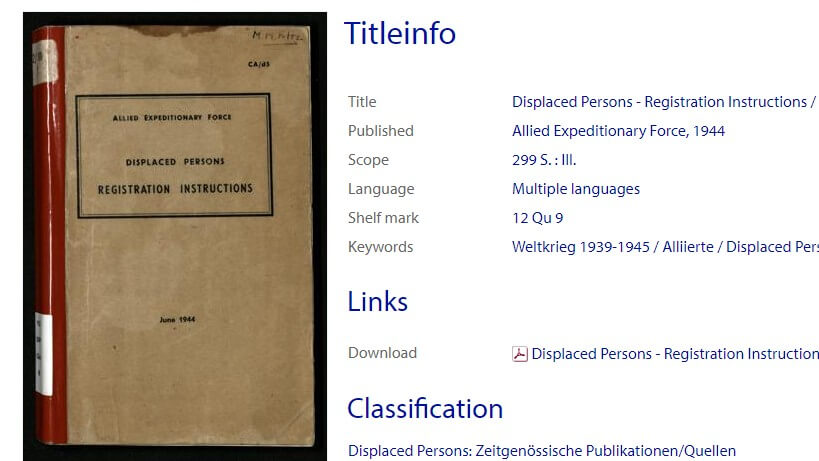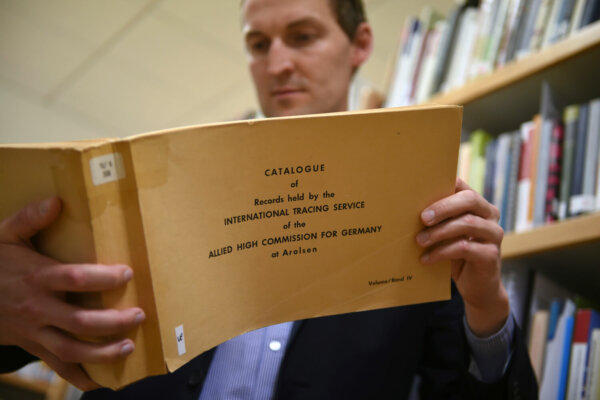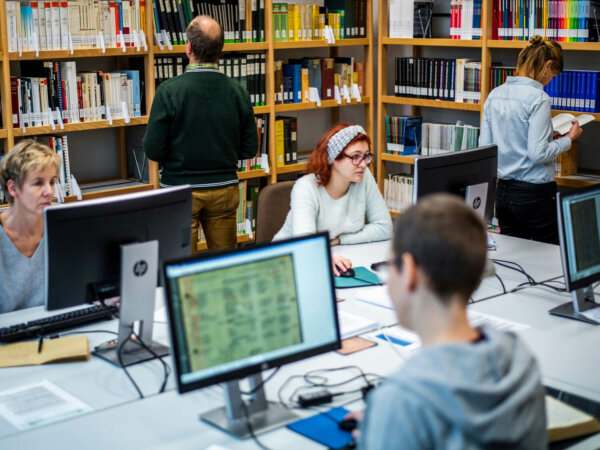Arolsen Archives publishing new Online Library

Not only are the Arolsen Archives publishing millions of documents online. They are also making books and magazines available in a digital library. The new online portal aroa.to/online-library enables users to conduct research quickly and accurately and provides useful search and filter options. New content is being added all the time. Henning Borggräfe, Head of Research and Education, Christian Groh, Head of Archives, and Nicole Tödtli, Head of the Reference Services team, discuss the beginnings of the new online library and the plans for its future development.
Book and magazines from the library of the Arolsen Archives will be available online as of April 17. What’s the idea behind this?
Henning Borggräfe: The idea of an online library first came up during joint discussions with other memorial sites. We have been involved with the Memorial Libraries Working Group (Arbeitsgemeinschaft der Gedenkstättenbibliotheken) for some years now, and we are keen to make valuable and rare holdings available in digital form to a wide specialist audience. Our own library contains some real gems, including materials on Displaced Persons and the early history of tracing services. We want to implement the online library project as quickly as possible, so we have made the first move, so to speak.
There will be an online portal for the digital library similar to the online archive of the Arolsen Archives. The technical infrastructure is being provided by semantics.
Henning Borggräfe: Exactly. We have already worked with semantics in the past. We developed the first version of the online archive with them before it was relaunched last year in partnership with Yad Vashem. However, we can still use the original online portal – now with new contents. The team at semantics have the specialist knowledge and the software solutions needed to implement and manage digital libraries and the standards that apply in this area. So working with a partner like them is the obvious solution – and a practical one too.
What had to be done in order to implement this project? What did things look like behind the scenes?
Nicole Tödtli: First of all, we had to make an initial selection and choose which books would be most suitable for online access. We used lists to get an overview and identify the right works. The books we chose then had to be picked out in the library and scanned in the Digitization department. Our IT department passed the data on to semantics, and they linked the data to the digital metadata of the individual books and uploaded everything to the new portal. It’s an inter-departmental project, and everyone is working together really well.

An initial selection of books for digital publication had to be identified, picked out in the library, and digitized before they were uploaded to the online portal.
Why are some books being put online while others aren’t?
Christian Groh: We have selected books that can be put online without infringing any copyright. This includes so-called grey literature, i.e. materials that were produced privately without going through a publishing house and without the restrictive rights that would then be involved. In our case, these are mostly publications that were authored or published by the ITS and that can be found in only a few other libraries across the world. They are now being made available for use by the general public. But we are also putting publications online that were produced by institutions that no longer exist and publications whose copyright has expired. At the moment, this mostly applies to publications about Displaced Persons as well as a lot of material on concentration camps. The plan is for publications on forced labor and the annual reports of the ITS to follow later.
Nicole Tödtli: We have to check the copyright of all the publications that do not come from our own institution on an individual basis. That is going to be our next step. That’s quite a challenge when you consider the fact that our physical library contains thousands of books…
What advantages will the new online library have for external users and for the staff of the Arolsen Archives?
Nicole Tödtli: Some of the publications that will be made available on the portal of the online library will not be visible to the public because of their copyright. Arolsen Archives staff and anyone who visits our reading room will be able to access these works online. The new online library will be a useful tool to our staff when they are working from home in future. As we are constantly expanding the options for working from home, it is very important for research associates in particular to have full access to research tools and work aids. This is especially true of recent literature that is not publicly available online. Our colleagues will be able to search these materials quickly and easily. Semantics has created tables of contents for all the publications, for example. This means that users can select specific chapters and then access the page they want directly with just one click.

Materials that cannot be accessed by the public can be searched in the reading rooms of the Arolsen Archives using the new online tool.
Henning Borggräfe: Thanks to the use of OCR for text recognition during digitization, we also have a very useful full text search that even functions across all publications. You just enter the word you are looking for, and the online portal displays every page in every online publication that contains the word you entered. This is of great advantage to users as it enables them to conduct their research in greater depth. It will also be a great help to our colleagues who need to search for information in order to respond to inquiries.
Christian Groh: The online functionality will help us in the analog world of paper, too. Books don’t have to be lent out so often in-house any more. That will mean less paperwork. But even more importantly, it will protect the rare originals and ensure that they are better preserved for posterity.
What are the plans for the future of the online library?
Christian Groh: The current selection of books is just the beginning. We plan to make it possible to use a lot more books online in future. And magazines will be added too. We are working on this project on a continuous basis. We can also imagine adding the collections of other related institutions to the portal so that users can find as much relevant literature as possible on one and the same portal. There would be a clear indication of which library holds the material, of course. Once we have launched the portal successfully, we will reach out to memorial libraries and other institutions.

